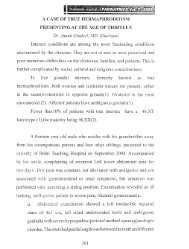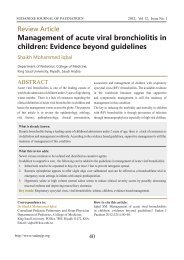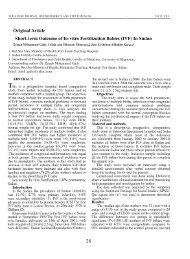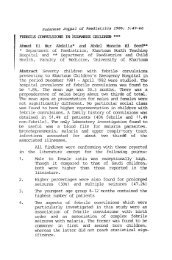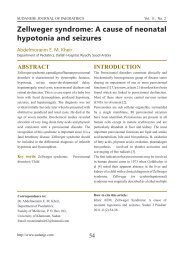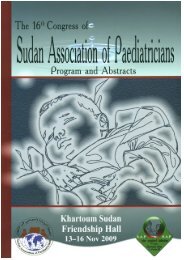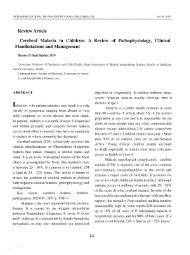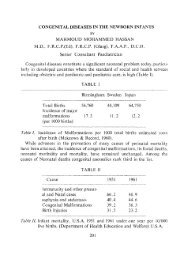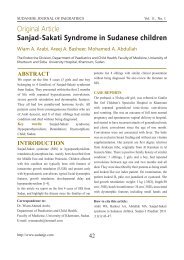conference programme and abstracts book - Sudanjp.org
conference programme and abstracts book - Sudanjp.org
conference programme and abstracts book - Sudanjp.org
You also want an ePaper? Increase the reach of your titles
YUMPU automatically turns print PDFs into web optimized ePapers that Google loves.
in class 11. 4 patients (30%) presented with cyanosis in addition to heart failure. Onepatient presented with palpitations.A wide range of associated diseases included chronic renal failure, impaired hearing,<strong>and</strong> growth failure with a characteristic facial appearance in males. Electrocardiographicabnormalities included peak, tall P wave (83%), Rsr pattern, first degree AVblock, atrial fibrillation, Wolf-Parkinson- White (WPW) <strong>and</strong> Mahaim type pre excitation.Associated echocardiographic abnormalities included mitral valve prolapse, leftventricle dysfunction, secundum atrial septal defect (ASD), pulmonary valve stenosis<strong>and</strong> pericardial effusion. One patient had tricuspid valve surgery <strong>and</strong> 3 are waiting forsurgery. 2 patients are awaiting trans-catheter ASD closure.Conclusion: The frequency of EA in this area (1.2 % of all congenital heart defects) ismore than double the average reported frequency. Many of associated diseases had notbeen reported in the literature.Enuresis ClinicDr. Abdelazim Mohamed Mabrouk,MBBS, MPCH. DCH. CABPSpecialist Paediatrician. AI Ain, United Arab EmiratesEnuresis is defined as the involuntary voiding at an age where urinary continence isexpected. It can be primary, secondary, nocturnal, diurnal, poly or monosymptomatic.The commonest type is the primary monosymptomatic nocturnal enuresis. This is definedas a complaint of bed wetting since birth <strong>and</strong> occurring during sleep without anyperiods of dryness in a child older than 5 to 6 years. It is not associated with symptomsof urgency, frequency or day time wetting. This represents more than 80% of cases.Numerous hypotheses had been suggested to explain the aetiology of this distressingproblem. The most acceptable one is the genetic predisposition where Nocturnal enuresiswas observed to run in families. Recently, the gene locus was identified to be inchromosome 13q <strong>and</strong> an autosomal eo-dominant mode was suggested. In those childrenthere was a lack of nocturnal secretion of the antidiuretic hormone vasopressin,resulting in large urine production at night. Children with overactive small bladdercapacity void small quantities of urine at intervals during the night.It was preferred that these children should be managed in a specialized enuresis clinic.This clinic provides evaluation <strong>and</strong> management for affected children who are abovethe age of six years. It adopts different management approaches including motivationaltherapy, behavioural modification <strong>and</strong> pharmacological treatment. It also provides in-



